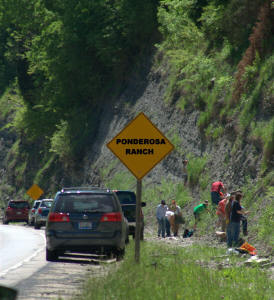
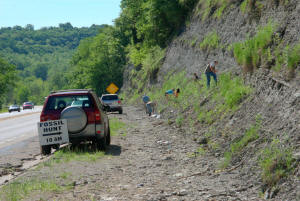
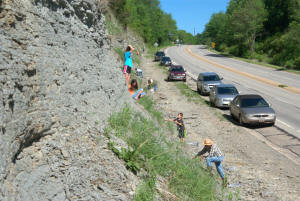
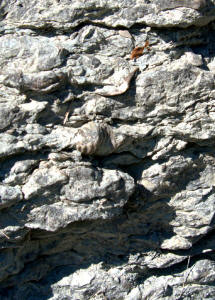
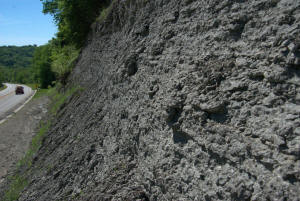
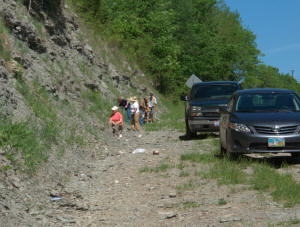
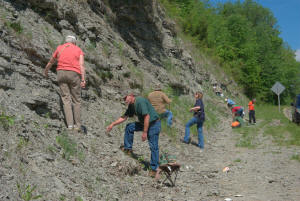
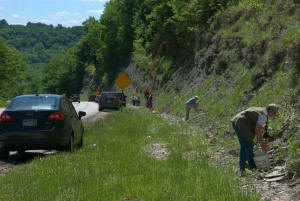
Photos and words by Bill Heimbrock
The Dry Dredgers returned to a couple of popular sites in Ohio east of Cincinnati. The sites were nicknamed "Ponderosa Ramch" because the Bellevue Formation exposed on both sites are loaded with a bonanza of the brachiopods Vinlandostrophia ponderosa and Rafinesquina ponderosa. Both sites are road cuts, not really a ranch or farm. We last visited there in 2009.
These sites also expose the bottom of the Corryville Formation, which is famous for lots of unusual and collectable fossils, such as Edrioasteroids, a type of echinoderm.
SITE 1
Here are some photos of the Dry Dredgers collecting at the first stop.
SITE 2
The second stop was pretty much just like the first stop, but less picked-over and smaller and kind of overgrown with weeds.
Fossils Found That Day
Trilobites
Probably the most interesting trilobite find was at the second
site. It was a glabella what is probably the trilobite
Amphilichas sp..
The next most interesting trilobite was this inverted, prone
Flexicalymene sp. (Site 1).
Other fragments of Flexi's were found too, such as this
thorax (Site 1).
The only other type of trilobite found that day was fragments
of Isotelus sp. (next 4 pics). These first 2 pictures
are from the pygidium (tail).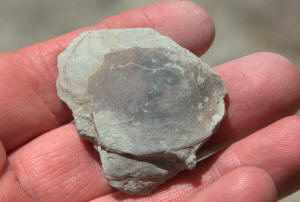
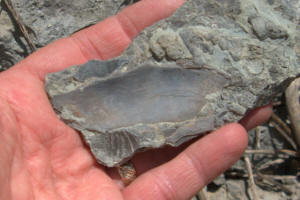
Edrioasteroids
On every field trip to this site there has been at least one
find of an Edrioasteroid. On this
site, the Edrios are always partials. Most of the time, these are found on site
#2. This time, the only Edrio was found on Site 1. It was very tiny - only about
5 mm. in diameter.
Crinoids
The best find was a couple of slabs of crinoids which include
calyxes. One of the slabs is pictured below.
They appear to be Pycnocrinus dyeri
(next 3 pics).
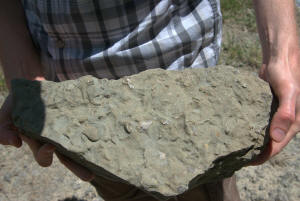
Crinoid stems were also found loose on the ground.
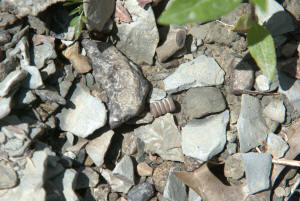
In addition to calyxes and stems, crinoid holdfasts were
found. Here's an interesting one. It's a holdfast of the crinoid
Anomalocrinus sp.
Brachiopods
In the Corryville Formation and in the piles below those
layers, a unique species of brahiopod is found - Rafinequina nasuta.
This species is distinguished from other Rafinesquina
species by a more triangular profile and a slight bump on the top edge. (next 2
pics).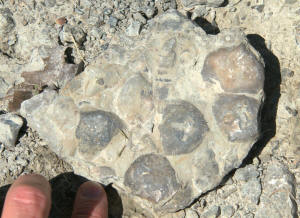
The more common variety of this brachiopod we found on both
sites was Rafinesquina ponderosa. (next 3 pics)
On the surface of these Rafinesquina, we found lots of the inarticulate brachiopod, Petrocrania scabiosa. (next 4 pics)
Here's an uncommon collectable item. These are
Petrocrania scabiosa that are free from the surface to which they
originally attached. Interesting.
The other brachiopod for which the "Ponderosa Ranch" was named is Vinlandostrophia ponderosa. We did not find a bonanza of these brachiopods this time. But good numbers were taken home by all. (next 4 pics).
Also in abundance was the smaller cousin of the P. ponderosa,
named Vinlandostrophia cypha. (next 3 pics)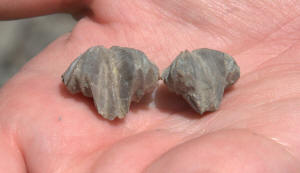
Also common was the sometimes beautiful, but often broken or
distorted brachiopod Hebertella occidentalis. (next 3
pics)
Bryozoans
Bryozoans are abundant throughout the
Cincinnatian. But there are many species and so they are just as collectable as
other fossils. We found numerous Parvohallopora ramosa,
amateurs can identify it by their raised monticules. (next 2 pics)
There were also lots of ramose (branching) bryozoans on slabs.
Many of the massive trepostomate bryozoans had strange holes
or borings in their surface called Trypanites. These
are not the holes in which the bryozoan polyps lived. They were animals
attaching themselves to the bryozoan colony, perhaps to share the bryozoans'
food source. (next 4 pics)
Another type of bryozoan we found were encrusters. Some of the
brachiopods had a chain-like structure on their surface. These were cyclostomate
bryozoans. (2 pics)
Cephalopods
Both of these sites were great site for finding
straight-shelled nautiloid cephalopods. Almost all were internal molds. These
were one of the major predators of the late Ordovician seas 440 million years
ago. (next 4 pics)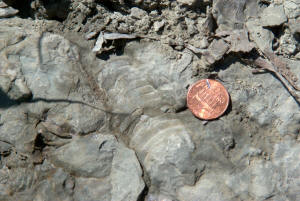
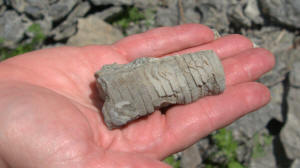
Pelecypods (bivalves/clams)
Clams are great! Whether you eat them fresh or collect them when they have fossilized, many Dredgers have a deep appreciation for these bivalve mollusks.
Most Ordovician clams were preserved as internal molds with no
external shell features preserved. A variety of clam we found that did have the
shell surface features preserved is Caritodens sp..
(next 2 pics)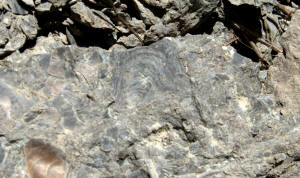
Here is a collection of some of the clams we found that were
internal molds. Without the shell, it's hard to tell what species they were.
Gastropods (snails)
Snails are also one of those great mollusks. There are lots of
species to collect. But often, identification to the species is difficult
because there are so many types that can be found in the Cincinnatian Series. An
easy one from this trip to identify was Cyclonema sp.
(next 2 pics).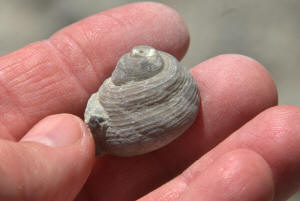
This next gastropod is probably Trochonema sp.
but might be Lophospira sp..
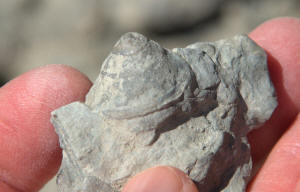
Ichnofossils (Trace Fossils)
We didn't find as many trace fossils as we would if we were in
the Kope or Fairview formations, but here is one of the interesting ones we did
find. It looks like trilobite burrows on a slab. In this case, the slab is
bottom side up and the burrows are represented by the mud that filled them in.
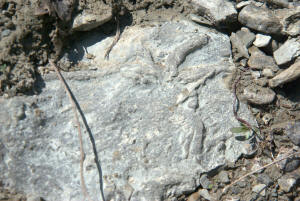
Worm Tubes
Occasionally we found brachiopods, such as this
Rafinesquina sp. that have Cornulites sp. worm tubes attached to
the feeding edge of the brachiopods. It is thought the worms position themselves
for optimal feeding of whatever the brachiopod is eating.
That's all for this field trip. Hope you enjoyed it. Join us for our field trip to the Penn Dixie site in New York State and the Ridgemount Quarry in Ontario, Canada. (photos not yet available).
Now let's see pictures of our June 2014 field trip to Penn Dixie and Ridgemount Quarry.
See photos of our previous trips to the Ponderosa Ranch.
Back to the Field Trip Index Page
Return to Dry Dredgers Home Page
The Dry Dredgers and individual contributors reserve the
rights to all information, images, and content presented here. Permission to
reproduce in any fashion, must be requested in writing to admin@drydredgers.org.
www.drydredgers.org is designed and maintained by Bill Heimbrock.